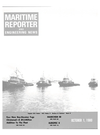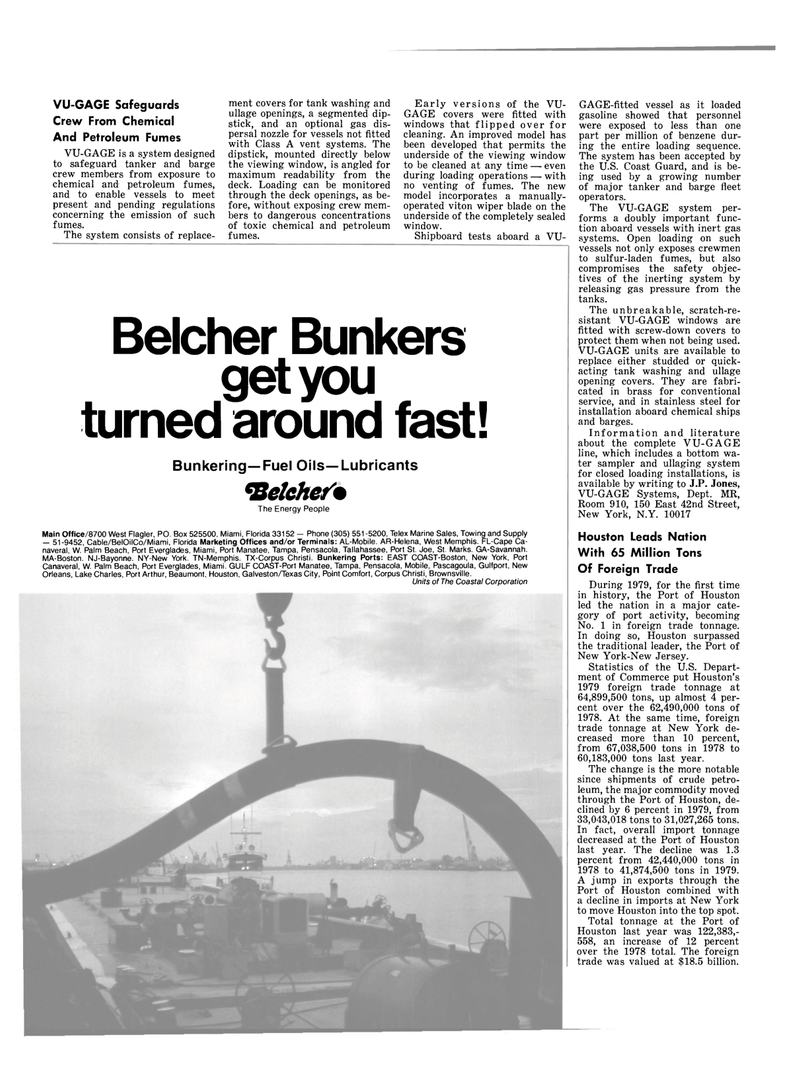
Page 28: of Maritime Reporter Magazine (October 1980)
Read this page in Pdf, Flash or Html5 edition of October 1980 Maritime Reporter Magazine
VU-GAGE Safeguards
Crew From Chemical
And Petroleum Fumes
VU-GAGE is a system designed to safeguard tanker and barge crew members from exposure to chemical and petroleum fumes, and to enable vessels to meet present and pending regulations concerning the emission of such fumes.
The system consists of replace- ment covers for tank washing and ullage openings, a segmented dip- stick, and an optional gas dis- persal nozzle for vessels not fitted with Class A vent systems. The dipstick, mounted directly below the viewing window, is angled for maximum readability from the deck. Loading can be monitored through the deck openings, as be- fore, without exposing crew mem- bers to dangerous concentrations of toxic chemical and petroleum fumes.
Early versions of the VU-
GAGE covers were fitted with windows that flipped over for cleaning. An improved model has been developed that permits the underside of the viewing window to be cleaned at any time — even during loading operations — with no venting of fumes. The new model incorporates a manually- operated viton wiper blade on the underside of the completely sealed window.
Shipboard tests aboard a VU-
Belcher Bunkers get you turned around fast!
Bunkering—Fuel Oils—Lubricants ^Selehe/m
The Energy People
Main 0ffice/8700 West Flagler, PO. Box 525500, Miami, Florida 33152 — Phone (305) 551 -5200, Telex Marine Sales, Towing and Supply — 51-9452, Cable/BelOilCo/Miami, Florida Marketing Offices and/or Terminals: AL-Mobile. AR-Helena, West Memphis. FL-Cape Ca- naveral, W. Palm Beach, Port Everglades, Miami, Port Manatee, Tampa, Pensacola, Tallahassee, Port St. Joe, St. Marks. GA-Savannah.
MA-Boston. NJ-Bayonne. NY-New York. TN-Memphis. TX-Corpus Christi. Bunkering Ports: EAST COAST-Boston, New York, Port
Canaveral, W. Palm Beach, Port Everglades, Miami. GULF COAST-Port Manatee, Tampa, Pensacola, Mobile, Pascagoula, Gulfport, New
Orleans, Lake Charles, Port Arthur, Beaumont, Houston, Galveston/Texas City, Point Comfort, Corpus Christi, Brownsville.
Units of The Coastal Corporation
GAGE-fitted vessel as it loaded gasoline showed that personnel were exposed to less than one part per million of benzene dur- ing the entire loading sequence.
The system has been accepted by the U.S. Coast Guard, and is be- ing used by a growing number of major tanker and barge fleet operators.
The VU-GAGE system per- forms a doubly important func- tion aboard vessels with inert gas systems. Open loading on such vessels not only exposes crewmen to sulfur-laden fumes, but also compromises the safety objec- tives of the inerting system by releasing gas pressure from the tanks.
The unbreakable, scratch-re- sistant VU-GAGE windows are fitted with screw-down covers to protect them when not being used.
VU-GAGE units are available to replace either studded or quick- acting tank washing and ullage opening covers. They are fabri- cated in brass for conventional service, and in stainless steel for installation aboard chemical ships and barges.
Information and literature about the complete VU-GAGE line, which includes a bottom wa- ter sampler and ullaging system for closed loading installations, is available by writing to J.P. Jones,
VU-GAGE Systems, Dept. MR,
Room 910, 150 East 42nd Street,
New York, N.Y. 10017
Houston Leads Nation
With 65 Million Tons
Of Foreign Trade
During 1979, for the first time in history, the Port of Houston led the nation in a major cate- gory of port activity, becoming
No. 1 in foreign trade tonnage.
In doing so, Houston surpassed the traditional leader, the Port of
New York-New Jersey.
Statistics of the U.S. Depart- ment of Commerce put Houston's 1979 foreign trade tonnage at 64,899,500 tons, up almost 4 per- cent over the 62,490,000 tons of 1978. At the same time, foreign trade tonnage at New York de- creased more than 10 percent, from 67,038,500 tons in 1978 to 60,183,000 tons last year.
The change is the more notable since shipments of crude petro- leum, the major commodity moved through the Port of Houston, de- clined by 6 percent in 1979, from 33,043,018 tons to 31,027,265 tons.
In fact, overall import tonnage decreased at the Port of Houston last year. The decline was 1.3 percent from 42,440,000 tons in 1978 to 41,874,500 tons in 1979.
A jump in exports through the
Port of Houston combined with a decline in imports at New York to move Houston into the top spot.
Total tonnage at the Port of
Houston last year was 122,383,- 558, an increase of 12 percent over the 1978 total. The foreign trade was valued at $18.5 billion.

 27
27

 29
29
